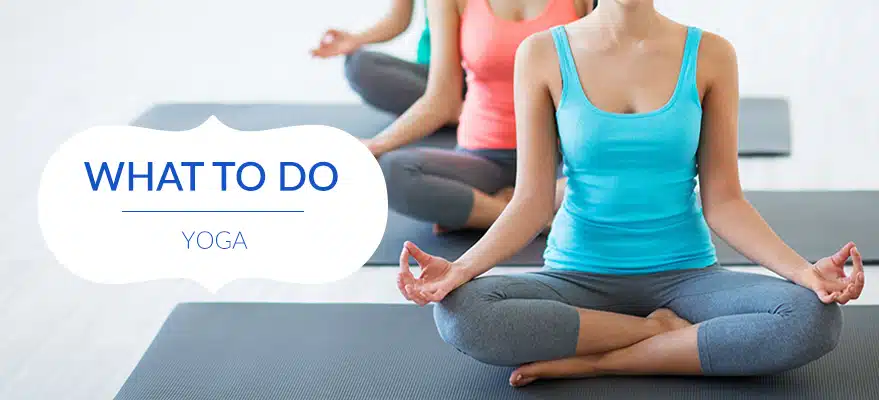Top Benefits of Yoga For Athletes

By Laura Cipullo, RD, CDE, CEDRD
Practicing yoga has the potential to improve your athleticism on every level. Regardless of the sport, give time to learn this ancient practice. In fact, most professional and collegiate level sport teams have their very own registered yoga teacher! Yoga has become a standard practice included in the training regimens of athletes for the purposes of (but not limited to) increasing balance and flexibility, while decreasing oxygen consumption. Read on to identify why yoga is beneficial to all who participate in sports.
Embody
As an athlete, your body is a finely tuned machine. L’ifestyle Lounge’s Elyssa Toomey, RD, RYT and trained yogi for athletes says “Yoga can teach you how to connect and how to carefully listen to your body’s cues. You can then recognize its’ cues in order to know when to slow down, speed up, work harder, or take a break.”
Muscular Symmetry
If you solely practice one sport, you may be building strength in just one or two areas of your body. If your sport is one-side dominant such as tennis, you may be further creating an imbalance. Toomey says, “A consistent practice of varied yoga poses will help you build strength in almost every muscle, including under-developed, but oh so important supportive muscles.” Practicing each sequence on both sides of the body helps to develop muscular symmetry.
|
Endurance
Yoga can increase your muscular endurance. In fact, research found women who practiced yoga three times a week, benefited from both increased upper limb and abdominal muscle endurance (Shiraishi and Bezerra, 2016) Yoga helps to loosen physical tightness and expels lactic acid from building up in the muscles, raising your energy level for continued practice and performance.
Flexibility and Balance
The sequences of the asanas, also known as postures, are designed to help the athlete increase flexibility and ease of movement both on and off the mat, specifically by increasing muscle, joint and tendon flexibility. This increase in range of motion translates to an increase in the performance of all the muscles needed for your particular sport. Research reported in the International Journal of Yoga found an increase in both flexibility and balance in Division II college athletes who practiced yoga just twice a week for 10 weeks (Polsgrove, Eggleston and Lockyer, 2016). Hint – get to the yoga studio two or more times a week.
Injury Prevention & Recovery
Yoga helps strengthen all the stabilizing muscles, vital to protecting your joints. Toomey shares, “specific poses elongate and stretch the muscles, which counter the contraction created during most athletic pursuits.”
Stress Relief and Mental Focus
While the pressure to perform can be overwhelming for the competitive athlete, yoga and pranayama, the practice of controlled breathing, reduces stress hormones such as cortisol. Controlled breathing is proven to increase your oxygen capacity while simultaneously keeping you calm. The athlete can remain mentally focused without tensing/tightening the muscles. “The practice promotes equanimity by working to quiet the seemingly continuous mental chatter that permeates our daily experience. As we learn to quiet and direct the mind, we have the opportunity to connect more fully with and express our “best self”” says Toomey.
In a literature review, Psychophysiologic Effects of Hatha Yoga on Musculoskeletal and Cardiopulmonary Function, James Raub, MS concludes that the practice of yoga is clinically beneficial with studies showing improved lung capacity, increased oxygen delivery, decreased V. O2 and respiration rate, and decreased resting heart rate, resulting in overall improved exercise capacity. The stretching and conditioning that occurs while holding yoga postures specifically in Hatha yoga “increases skeletal muscle oxidative capacity and decreases glycogen utilization” which can translate into a more efficient metabolic system while performing exercise (Raub, 2002). Thirty minutes of passive muscle stretch can be just as beneficial with increased muscle growth and contractile strength (Frankeny, Holly and Ashmore, 1983; Holly et al., 1980).
It is clear, there is evidence to support the many benefits of practicing yoga. Whether you or your children are soccer enthusiasts, football players or any type of athlete, yoga is now considered to be an advantageous tool in increasing athletic performance and flexibility. The L’ifestyle Lounge philosophy encourages all athletes including casual fitness goers who spin and run, to complement their physical activity with yoga, especially forms of Ashtanga and Hatha. For further inspiration, our Registered Dietitian and Registered Yoga Instructor, Elyssa Toomey recommends reading The Athlete’s Guide to Yoga An Integrated Approach to Strength, Flexibility, and Focus, (Roundree, Sage. 2008), signing up for our Breathe and Bend class, to increase flexibility and learn the breathe work, and/or our Rock, Sweat Glow class for strengthening and balance.
References
Frankeny, J., Holly, R. and Ashmore, C. (1983). Effects of graded duration of stretch on normal and dystrophic skeletal muscle. Muscle & Nerve, 6(4), pp.269-277.
Holly, R., Barnett, J., Ashmore, C., Taylor, R. and Mole, P. (1980). Stretch-induced growth in chicken wing muscles: a new model of stretch hypertrophy. American Journal of Physiology – Cell Physiology, 238(1), pp.C62-C71.
Polsgrove, M., Eggleston, B. and Lockyer, R. (2016). Impact of 10-weeks of yoga practice on flexibility and balance of college athletes. International Journal of Yoga, 9(1), p.27.
Raub, J. (2002). Psychophysiologic Effects of Hatha Yoga on Musculoskeletal and Cardiopulmonary Function: A Literature Review. The Journal of Alternative and Complementary Medicine, 8(6), pp.797-812.
Shiraishi, J. and Bezerra, L. (2016). Effects of yoga practice on muscular endurance in young women. Complementary Therapies in Clinical Practice, 22, pp.69-73.



